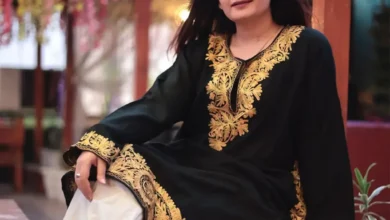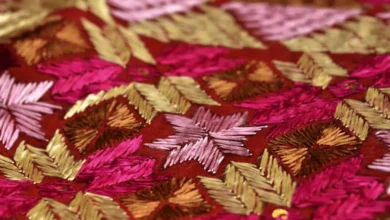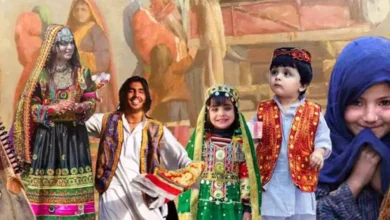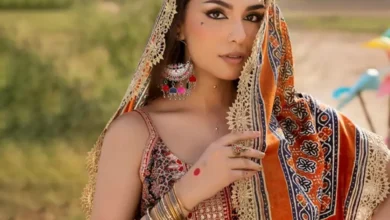Discover the vibrant, symbolic world of Balochi embroidery — a nomadic art form stitched with identity, resistance, and ancestral wisdom. Explore the meaning behind motifs, colors, and tribal dresses of Balochistan.
Threads That Travel — The Soul of Balochi Embroidery
In the windswept mountains and arid plains of Balochistan — a land straddling Pakistan, Iran, and Afghanistan — women sit under desert skies, needle in hand, stitching stories into cloth.
They’re not making “fashion.”
They’re weaving identity. Resistance. Legacy.
See also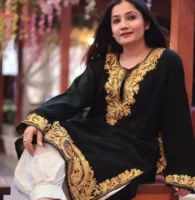 The Kashmiri Pheran: Tradition and Elegance in the Himalayan Region
The Kashmiri Pheran: Tradition and Elegance in the Himalayan RegionThis is Balochi embroidery — one of the world’s most intricate, symbolic, and resilient textile traditions. Born in tents, perfected over centuries, and worn with fierce pride, it transforms simple cotton and wool into wearable archives of nomadic life.
Each stitch? A memory.
Each mirror? A shield.
Each pattern? A map of belonging.
Let’s journey into the heart of Balochistan — where thread is tribe, and embroidery is endurance.
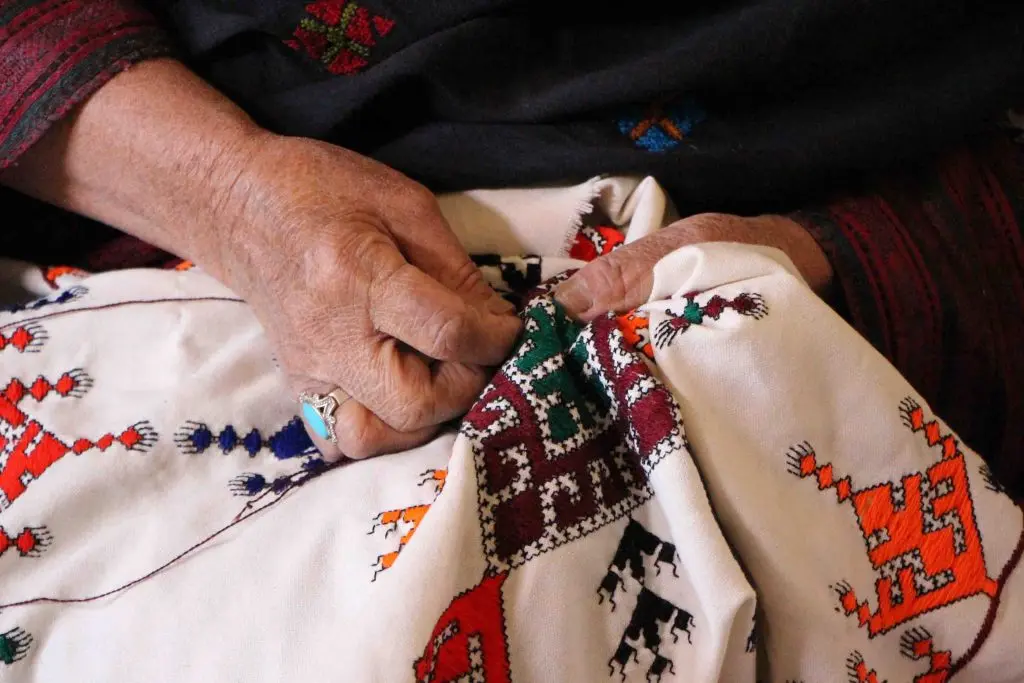
🧵 What Is Balochi Embroidery? The Art of the Desert
Balochi embroidery is a hand-stitched textile art practiced primarily by Baloch women across Pakistan’s Balochistan province, southeastern Iran, and southern Afghanistan.
See also Pashtun Attire: Pakol Caps, Shalwar Kameez, and Cultural Identity
Pashtun Attire: Pakol Caps, Shalwar Kameez, and Cultural IdentityUnlike urban or courtly embroideries, Balochi work is tribal, portable, and deeply personal — designed for a nomadic lifestyle where beauty travels with you.
✨ Key Features:
- Base Fabric: Cotton, wool, or silk — often handwoven and undyed
- Thread: Silk or cotton, in bold, saturated colors
- Stitches: Mirror work (shisha), chain stitch, satin stitch, herringbone, and buttonhole stitch
- Motifs: Geometric shapes, stylized animals, plants, and cosmic symbols
- Adornments: Tiny mirrors (shisha), beads, shells, and sometimes coins or cowrie shells
🌵 “We carry our homes on our backs — and our history on our sleeves.” — Baloch elder, Makran
📜 Roots in the Sand: A 2,000-Year Legacy
Balochi embroidery traces its origins to the nomadic tribes of Central Asia, who migrated into the Balochistan region over 2,000 years ago.
Historically, embroidery was:
- A dowry tradition — girls stitched garments for their future homes
- A tribal identifier — patterns revealed clan, region, and marital status
- A spiritual shield — mirrors warded off evil; red threads protected from envy
- A portable art — lightweight, durable, and packed easily for migration
Even today, in remote villages of Makran, Kalat, Sibi, and Chagai, women gather to stitch — passing patterns from mother to daughter, aunt to niece.
💔 Historical Note: Decades of conflict, displacement, and economic hardship have threatened this craft — but Baloch women are fighting back, stitch by stitch.
🎨 The Language of Patterns: What the Motifs Mean
Balochi embroidery is a visual language. Every shape, color, and placement tells a story.
🔺 Common Motifs & Their Meanings
| Diamonds & Triangles | Mountains, strength, protection | Makran, Kalat |
| Peacocks & Birds | Freedom, beauty, divine messengers | Coastal Balochistan |
| Camels & Horses | Nomadic life, travel, endurance | Northern Balochistan |
| Trees & Flowers | Fertility, growth, oasis in the desert | Sibi, Quetta |
| Sun & Moon | Cosmic balance, divine blessing | All regions |
| Mirrors (Shisha) | Ward off evil eye, reflect blessings, capture light in darkness | Universal |
🪞 Cultural Insight: “The mirror doesn’t just decorate — it defends. It says: ‘I am seen. I am protected. I shine even in shadows.’”
🎨 Color Symbolism: The Desert’s Palette
In Balochi embroidery, color isn’t decorative — it’s ritual.
| Red | Courage, passion, protection from evil | Weddings, festivals, daily wear |
| Black | Strength, mourning, resilience | Widows, funerals, protest attire |
| White | Purity, peace, spirituality | Elders, religious events |
| Green | Fertility, nature, Islam | Spring, childbirth, Eid |
| Gold/Yellow | Wealth, sun, divine light | Brides, celebrations |
| Blue | Water, sky, healing | Coastal tribes, healing rituals |
💧 In a land where water is sacred, blue thread is prayer.
👗 Traditional Balochi Tribal Dresses: More Than Clothing
Balochi embroidery adorns several key garments — each with cultural, social, and spiritual significance.
👘 Women’s Attire
Pashk (or Paskh)
- A long, loose tunic — often reaching the ankles
- Heavily embroidered on chest, shoulders, cuffs, and hem
- Worn with baggy trousers (shalwar) and a headscarf (chador or sarig)
Jameh
- A fitted dress, sometimes with a flared skirt
- Richly embroidered — especially for brides
- Often paired with a heavily mirrored vest or cape
Sarig / Chador
- Head-to-toe veil or shawl — embroidered along the edges
- Mirrors stitched along the forehead line — for protection and beauty
👔 Men’s Attire
While less ornate, Baloch men also wear embroidered pieces:
- Jamak — long tunic with side slits, embroidered on collar and cuffs
- Pagg / Turban — wrapped in specific styles by tribe; sometimes with embroidered ends
- Waistcoats — for special occasions, with mirror work and chain stitch
🐪 Fun Fact: A bride’s full outfit can take 6 months to 2 years to complete — stitched by female relatives as a communal act of love.
🧵 The Making: A Stitched Sanctuary
Creating Balochi embroidery is slow, sacred, and social.
The Process:
- Design Selection — Chosen by the wearer or elder women; never drawn — stitched freehand
- Fabric Prep — Washed, sun-dried, sometimes stiffened with starch
- Thread & Mirror Prep — Silk floss sorted by color; mirrors backed with black fabric
- Stitching — Done seated on floor, fabric stretched over knees or small frame
- Finishing — Hemmed, sometimes scented with rosewater or sandalwood
🌙 Artisan Wisdom: “You don’t stitch when you’re angry. The thread remembers. The mirror reflects it back.”
🔄 Modern Revival: From Tents to Runways
Once fading under economic pressure and cultural erosion, Balochi embroidery is now experiencing a powerful revival — worn by activists, showcased by designers, and celebrated globally.
👗 Fashion Fusion
- Designers like Maheen Khan, Sania Maskatiya, and Balochistan-based cooperatives are featuring Balochi motifs in haute couture — capes, gowns, jackets, even menswear
- International platforms like Lahore Fashion Week and Crafts Council exhibitions spotlight Baloch artisans
- Celebrities like Mehwish Hayat and Sanam Baloch wear Balochi embroidery to red carpets and talk shows
🛍️ Everyday Wear
- Balochi-print masks, tote bags, phone cases, sneakers
- Embroidered jean jackets, kurtas, and tunics for urban wear
- Youth proudly posting #BalochiEmbroidery and #WearBalochistan on Instagram and TikTok
🏛️ Preservation Efforts
- UNESCO considering Balochi embroidery for Intangible Cultural Heritage status
- NGOs like Anjuman-e-Himayat-e-Balochistan and Balochistan Rural Support Programme training young women in stitching and entrepreneurship
- Government initiatives promoting “Made in Balochistan” handicrafts
🖌️ “They tried to bury us. They didn’t know we were seeds — and our embroidery? That’s how we bloom.”
🌱 Challenges: Can Tradition Survive Conflict and Commerce?
Despite its revival, Balochi embroidery faces serious threats:
- ⚠️ Machine-made imitations — flooding markets, undercutting artisans
- ⚠️ Displacement & conflict — disrupting transmission of skills
- ⚠️ Loss of natural materials — silk floss, handwoven cotton replaced by synthetics
- ⚠️ Cultural appropriation — mass brands using motifs without credit or compensation
✅ How You Can Help
- Buy hand-embroidered pieces from Baloch women’s cooperatives (not mass retailers)
- Support fair-trade brands like Hunar Balochistan, Makran Crafts, Turbat Artisans
- Visit craft villages — meet the makers, learn the stitches
- Share the story — online, in classrooms, at cultural events
🖌️ “Don’t just wear Balochi embroidery. Know its hands. Honor its history. Defend its future.”
Quick Reference: Balochi Embroidery at a Glance
| Origin | Balochistan region (Pakistan, Iran, Afghanistan) |
| Meaning | Tribal identity, spiritual protection, nomadic heritage |
| Base Fabric | Cotton, wool, silk — handwoven |
| Thread | Silk or cotton floss |
| Key Motifs | Mirrors, diamonds, camels, peacocks, sun/moon |
| Stitches | Mirror work, chain stitch, satin stitch, herringbone |
| Time to Make | 3 months – 2 years (for bridal sets) |
| Modern Use | Bridal wear, fashion, activism, home décor |
FAQs: Balochi Embroidery
❓ Is Balochi embroidery only for women?
Traditionally, yes — but today, men’s vests, turbans, and jackets are also embroidered, especially for weddings and cultural events.
❓ What’s the significance of mirrors in Balochi embroidery?
Mirrors (shisha) are believed to ward off the evil eye, reflect blessings, and symbolize light in darkness — essential in a harsh desert landscape.
❓ How can I tell if a Balochi piece is authentic?
Look for:
→ Hand-stitched (not machine-printed)
→ Irregularities (perfect symmetry = likely fake)
→ Backside shows stitching (machine work is clean on back)
→ Sold by Baloch women’s cooperatives or certified artisans
❓ Why is red the most common color?
Red symbolizes protection, passion, and life force — vital in a culture that has endured centuries of hardship. It’s also believed to repel envy and evil.
Conclusion: Stitched in Sand, Woven in Spirit
Balochi embroidery is not craft.
It’s resistance stitched in silk.
It’s ancestral maps in thread.
It’s women’s voices woven into cloth — loud, proud, unbroken.
In a world that tries to silence, erase, or commodify Baloch identity — the needle becomes a weapon. The mirror, a shield. The pattern, a flag.
So next time you see a flash of red, a glint of mirror, a swirl of desert motif — don’t just admire the beauty.
Pause.
Honor the hands that made it.
Respect the land that inspired it.
Amplify the voices that wear it.
Because in Balochistan, heritage isn’t hung on walls.
It’s worn —
in sun.
in sand.
in struggle.
in splendor.
🧵🪞🏜️

